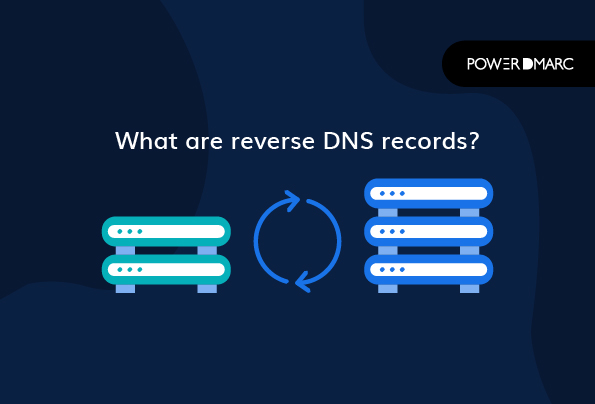Reverse DNS record is another email security method that, upon querying, shows domain names corresponding to their IP addresses. It’s also termed reverse lookup, as it does the opposite of what a forward DNS lookup does.
PTR DNS reverse record isn’t widely adopted because it isn’t critical to normal internet functions. But we’ll discuss why you shouldn’t ignore it for your domains.
What is Reverse DNS and How Does it Work?
A reverse DNS lookup is a DNS query in which a domain name connected to its corresponding IP address is returned as a result. It’s the exact opposite of a DNS lookup, where IP addresses corresponding to a domain name are presented upon querying.
The process is done with a PTR reverse DNS record that returns the domain name linked to the queried IP address. A PTR record also highlights syntax errors in your record and fixes misconfigurations. It works opposite to the DNS A record, which shows IP addresses connected to queried domains.
Uses of Reverse DNS Records
Performing reverse DNS lookups aids B2B business owners in understanding the nature and requirements of their target group. This further helps them decide how to cater to their audience’s needs and pain points through products and services.
Secondly, email servers use reverse lookups to run verification checks on emails to block the entry of illegitimate messages into their customers’ mailboxes targeted by malicious actors. If a mail server fails to find a valid PTR record for your domain, it considers the domain suspicious. This impacts your domain’s email deliverability. However, if this also happens for legitimate emails, then deploying SPF, DKIM, and DMARC is advised.
By setting the appropriate DMARC policy, you can choose how recipients’ mailboxes should treat emails sent from your domain that fail authentication checks.
Why is DNS Reverse Record Important?
A DNS reverse record helps in reverse DNS lookup that bears the following advantages-
Filtering Spam Emails
Email servers often use reverse DNS records to stop spamming and phishing by bouncing off emails from IP addresses without reverse DNS.
Analytics
A DNS reverse record provides human-readable data in analytics instead of enlisting IP addresses in a logbook format.
Website Visitors’ Registration
Reverse DNS lookups keep track of visitors to your website, which can be further evaluated to understand your audience’s type and behavior. This helps in SEO ranking and lead generation, which boost your business sales and market reputation. Furthermore, a wide range of consulting services are available to guide in optimizing online presence and leveraging visitor data effectively.
Optimum Network Experience
You get a smooth network experience by managing problems related to r-commands, SMTP servers, or network backup systems. Reverse DNS lookup is also one of the prerequisites by some ISPs.
Security
You can use a DNS reverse record to sort an IP address’ A record which points a domain name to the physical IP address of the device hosting that domain.
How To Perform a Reverse DNS Lookup?
A reverse DNS lookup has benefits ranging from spam blocking to lead generation and better business reputation. Here’s how you can perform it:
1. For Windows Users
In the Windows command prompt, type nslookup followed by the IP address and hit ‘Enter.’
It will look something like- nslookup1.23.45
Once done, you will see the DNS name of the IP address you entered. There will be an error if the system is unable to find the records.
2. For Linux Users
Use dig command- dig -x [ip_address]
The terminal will display the domain name corresponding to the queried IP address.
3. Using Reverse DNS Lookup Tool
Use PowerDMARC’s free PowerTool, choose the lookup type, enter the IP address in the search box, and hit the search button. You will see the domain name associated with the IP address you entered.
How to Resolve DNS Reverse Lookup Failed Error?
You may come across the following error-
Task ‘me@mydomain.com ‘ Sending reported error: ‘The server responded: 550 This system is configured to reject mail from 999.111.999.222 [999.111.999.222] (DNS reverse lookup failed)’
You can resolve this in the following steps-
- Check if your PTR record is registered on your DNS.
- Create a conditional forwarder.
- Connect with your ISP to add your PTR record to DNS for open access. This will link FQDN or Fully Qualified Domain Name and IP address.
The domain name section of the FQDN should be the same as the sending SMTP addresses.
If you still face issues resolving DNS reverse lookup errors for your domain, then get in touch with our experts. We can help you create PTR reverse DNS records to promote email security, receive human-readable data in analytics, and offer a smooth network experience to visitors.
- Rise in Tax Scams and IRS Email Impersonation Attacks During Tax Season - May 2, 2024
- Email Safety 101 to Fight Crypto Scams - April 30, 2024
- How to Find the Best DMARC Solution Provider for Your Business? - April 25, 2024
